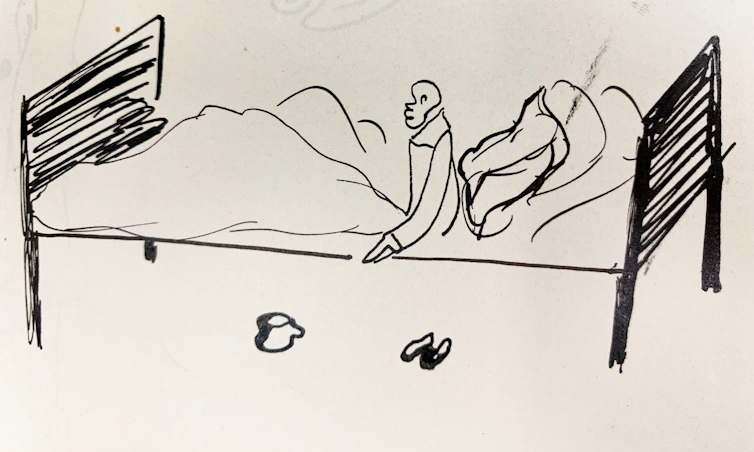Throughout his work, Franz Kafka depicts bodies disabled by the exhausting effects of the workplace. In Amerika (1911 to 1914), set in an era of early 20th-century free-market enterprise, Kafka portrays the gruelling consequences of overwork on desperate people.
Reminiscent of the menial graft in Victorian classic David Copperfield, in one scene an exhausted labourer is crushed by falling bricks in front of her child. Later, a disabled woman imprisoned in her bedroom must rely on her lodgers to care for her. With near-Dickensian irony, their board is paid not with money but by this inadequate round-the-clock care.
Commemorating 100 years since Kafka’s death, many are revisiting his stories. A focus on how disabled bodies relate to the workplace brings a new appreciation of his fiction, as well as both his professional and personal life.
This means examining experiences of disability, which often involve hostility, accusations of laziness, and an acknowledgement of the desperation faced by people who lack meaningful support. This is wrought raw in Kafka’s work as his characters struggle against systems that actively prevaricate, disregard and ignore them.
Poignantly, in these stories we encounter characters who embody urgent concerns of today. For instance, A Country Doctor (1917) struggles against limited resources that result in his failure to save a wounded child’s life, while The Hunger Artist (1922) starves himself to death inside a cage for the entertainment of passersby.

This article is part of our series marking 100 years since the death of writer Franz Kafka. These articles explore his legacy and influence on everything from cinema to law. To read more, click here
Countless times, Kafka places disabled bodies in opposition to modernity’s unjust and arbitrary demands. He emphasises the material conditions by which we are forced to live and die: an impoverished welfare state, reduced medical care, a person’s suffering as spectacle.
This literary preoccupation is partly informed by real life. Kafka witnessed countless pressures on disabled people in his professional career at The Workers’ Accident Insurance Institute in Prague.
The biographer Reiner Stach imagines Kafka arriving at his office “to speak to disabled accident victims or comfort bereaved family members”. Stach also provides literature commonly circulated around Kafka’s workplace, giving us a grim insight of the “uses for the disabled” throughout the Hapsburg Empire.

Der Arbeitnachweis (Legal Regulation of Public Employment Offices in Austria, 1915) includes a section for hairdressers in which “facial disfigurement and the wearing of eyeglasses constitute an inability to work, because the sight of wounded or disfigured hairdressers’ assistants drives away customers”.
That a “disfigured”, bespectacled assistant should be rejected from employment in a hairdressing salon is a decision based purely on physical appearance – bodily differences dictate employment or social exclusion. Meanwhile, in another section for carpenters, “missing an eye or the jaw is not an impediment”.
Read more: Kafka 100: Stanley Kubrick's films are littered with references to the writer's work
This arbitrary decision-making and nightmarish bureaucracy, which disregards some but accepts others, has come to be known as Kafkaesque. It chimes troublingly with Ellen Clifford’s 2020 description in The War on Disabled People of institutional oppression against those undergoing the trial of work capabilities assessments.
Still today, the UK government scheme which decides eligibility for disability benefit is criticised as punitive and degrading. Its approach is deeply suspicious of those needing support, casting prospective claimants, like characters from a Kafka story, as trying to beat the system. The box-ticking format is poorly designed and does not accommodate the lived experiences of those people being processed.

Outside the office, Kafka’s hometown was founded on stories about disability and work. In Prague Pictures, Irish novelist John Banville recounts the story of Prague’s medieval astronomical clock, the Orloj. It was built by a master clockmaker “who did such a fine job that the town councillors, fearful he would make a replica elsewhere, had the unfortunate craftsman blinded”. This violent irony is a Kafkaesque conceit: someone so gifted in their work that they are punished for their skill.
Personally, Kafka was familiar with impairment.
In his family’s business ventures, there was the risk of ill health. Along with his father and brother-in-law, Franz became a shareholder in Prague’s first asbestos factory. Although there was little awareness of how carcinogens affected the body, his stories’ preoccupation with breathing problems and the tuberculosis from which he would eventually die indicate the disabling effects of industrialisation.
Consumption finally took away Kafka’s ability to speak in his last weeks, but he persevered and diligently wrote Josephine the Singer (1924), a story about a mouse who is excused from physical labour and who sings without a voice.
Despite her silence, and maybe because of it, the mouse’s audience remains spellbound, her curious art outlasting the body that produced it. This parallels Kafka, whose tales of bodies and work remain relevant to a captivated readership a century after his death.

